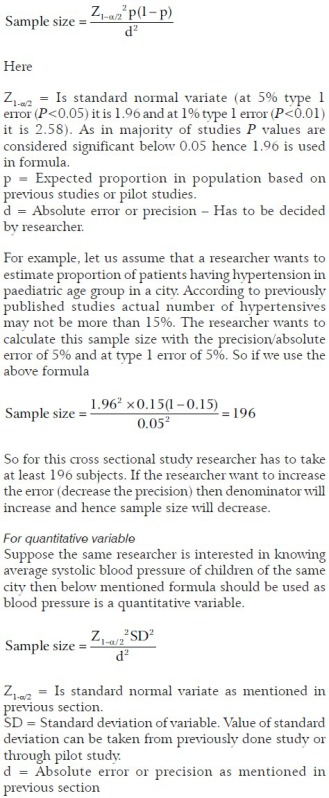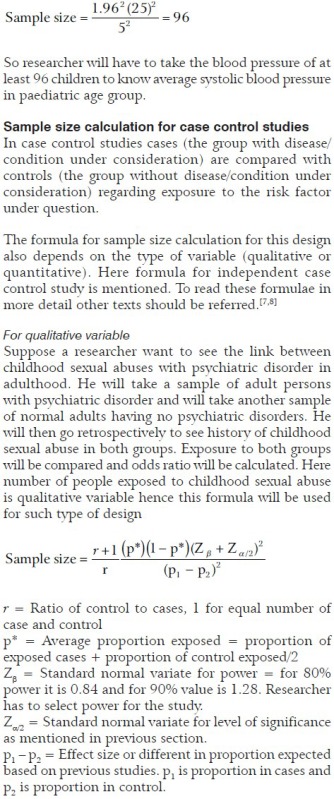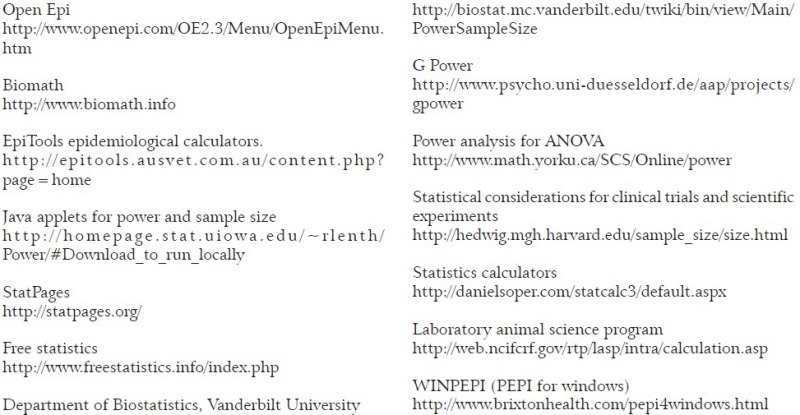Abstract
Calculation of exact sample size is an important part of research design. It is very important to understand that different study design need different method of sample size calculation and one formula cannot be used in all designs. In this short review we tried to educate researcher regarding various method of sample size calculation available for different study designs. In this review sample size calculation for most frequently used study designs are mentioned. For genetic and microbiological studies readers are requested to read other sources.
Keywords: Medical research, sample size, study designs
INTRODUCTION
In the recent era of evidence-based medicine, biomedical statistics has come under increased scrutiny. Evidence is as good as the research it is based on, which in turn depends on the statistical soundness of the claims it make. One of the important issues faced by a biomedical researcher during the design phase of the study is sample size calculation. Various studies published in Indian and International journals revealed that sample size calculations are not reported properly in the published articles. Many of the studies published in these journals have less than required sample size and hence less power.[1,2,3] Many articles have been published in existing literature explaining the methods of calculation of sample size but still a lot of confusion exists.[4,5,6] It is very important to understand that method of sample size calculation is different for different study designs and one blanket formula for sample size calculation cannot be used for all study designs. In this article different formulae of sample size calculations are explained based on study designs. Readers are advised to understand the basics of prerequisites needed for calculation of sample size calculation through this article and from other sources also and once they have understood the basics they can use different paid/freely available software available for sample size calculations. For simple study designs formulae given in this article can be used for sample size calculation.
Sample size calculation for cross sectional studies/surveys
Cross sectional studies or cross sectional survey are done to estimate a population parameter like prevalence of some disease in a community or finding the average value of some quantitative variable in a population. Sample size formula for qualitative variable and quantities variable are different.
For qualitative variable
Suppose an epidemiologist want to know proportion of children who are hypertensive in a population then this formula should be used as proportion is a qualitative variable.

So if the researcher is interested in knowing the average systolic blood pressure in pediatric age group of that city at 5% of type of 1 error and precision of 5 mmHg of either side (more or less than mean systolic BP) and standard deviation, based on previously done studies, is 25 mmHg then formula for sample size calculation will be

So if the researcher wants to calculate sample size for the above-mentioned case control study to know link between childhood sexual abuse with psychiatric disorder in adulthood and he wants to fix power of study at 80% and assuming expected proportions in case group and control group are 0.35 and 0.20 respectively, and he wants to have equal number cases and control; then the sample size per group will be

So, the researcher has to take 59 samples in each group.
It is worthy of mention here that these formulas for case control and cohort study are for independent design studies. They are not for matched case control and cohort studies. These formulae can be modified or corrected depending on population size or ratio between sample size and population size. Detailed text should be read to know more about technical aspects of sample size calculation.[7,8] Readers are advised to use various freely available epidemiological calculators like openEpi given in appendix to calculate sample size formula.
Sample size calculation for testing a hypothesis (Clinical trials or clinical interventional studies)
In this kind of research design researcher wants to see the effect of an intervention. Suppose a researcher want to see the effect of an antihypertensive drug so he will select two groups, one group will be given antihypertensive drug and another group will be give placebo. After giving these drug s for a fixed time period blood pressure of both groups will be measured and mean blood pressure of both groups will be compared to see if difference is significant or not. Complex formulae are used for this type of studies and we want to advise readers to use statistical software for calculation of exact sample size. The procedure for calculation of samle size in clinical trials/intervention studies involving two groups is mentioned here. In the case of only two groups method of calculation is mentioned here but if design involves more than two groups then statistical software like G Power should be used for sample size calculation. But understanding of various prerequisites which are needed for sample size calculation is very important.
Formula for sample size calculation for comparison between two groups when endpoint is quantitative data
When the variable is quantitative data like blood pressure, weight, height, etc., then the followingformula can be used for calculation of sample size for comparison between two groups.

So researcher needs 294 subjects per group.
So simple calculation for sample size when comparison is for two independent groups can be done manually by given formulae but for more than two groups or for matched data and for other complex calculations software should be used [appendix 1].
Sample size formula for animal studies
For animal studies there are two method of calculation of sample size. The most preferred method is the same method which has been mentioned in sample size calculation for testing the hypothesis. While all efforts should be done to calculate the sample size by that method, sometimes it is not possible to get information related to the prerequisites needed for sample size calculation by power analysis like standard deviation, effect size etc. In that condition a second method can be used this is called as “resource equation method”.[9] In this method a value E is calculated based on decided sample size. The value if E should lies within 10 to 20 for optimum sample size. If a value of E is less than 10 then more animal should be included and if it is more than 20 then sample size should be decreased.
E = Total number of animals - Total number of groups
Suppose in an animal study a researcher formed 4 groups of animal having 8 animals each for different interventions then total animals will be 32 (4 × 8). Hence E will be
E = 32 – 4 = 28
This is more than 20 hence animals should be decreased in each group. So if researcher takes 5 rats in each group then E will be
E = 20 – 4 = 16
E is 16 which lies within 10-20 hence five rats per group for four groups can be considered as appropriate sample size. This is a crude method and should be used only if sample size calculation cannot be done by power analysis method explained in above section for testing the hypothesis.
APPENDIX 1: – FREE SOFTWARE AND CALCULATORS AVAILABLE ONLINE FOR SAMPLE SIZE CALCULATION

Footnotes
Source of Support: Nil
Conflict of Interest: None.
REFERENCES
- 1.Jaykaran, Saxena D, Yadav P, Kantharia ND. Negative studies published in medical journals of India do not give sufficient information regarding power/sample size calculation and confidence interval. J Postgrad Med. 2011;57:176–7. doi: 10.4103/0022-3859.81861. [DOI] [PubMed] [Google Scholar]
- 2.Jaykaran, Yadav P, Kantharia ND. Reporting of sample size and power in negative clinical trials published in Indian medical journals. J Pharm Negative Results. 2011;2:87–90. [Google Scholar]
- 3.Jaykaran, Saxena D, Yadav P. Negative studies published in Indian Medical journals are underpowered. Indian Pediatr. 2011;48:490–1. [PubMed] [Google Scholar]
- 4.Naduvilath TJ, John RK, Dandona L. Sample size for ophthalmology studies. [Last cited in 2012 Sep 2];Indian J Ophthalmol [serial online] 2000 48:245. Available from: http://www.ijo.in/text.asp?2000/48/3/245/14864 . [PubMed] [Google Scholar]
- 5.Patra P. Sample size in clinical research, the number we need. Int J Med Sci Public Health. 2012;1:5–9. [Google Scholar]
- 6.Shah H. How to calculate sample size in animal studies? Natl J Physiol Pharm Pharmacol. 2011;1:35–9. [Google Scholar]
- 7.Kasiulevicius V, Sapoka V, Filipaviciute R. Sample size calculation in epidemiological studies. Gerontology. 2006;7:225–31. [Google Scholar]
- 8.Cai J, Zeng D. Sample size/power calculation for case-cohort studies. Biometrics. 2004;60:1015–24. doi: 10.1111/j.0006-341X.2004.00257.x. [DOI] [PubMed] [Google Scholar]
- 9.Festing MF, Altman DG. Guidelines for the design and statistical analysis of experiments using laboratory animals. Institute for Laboratory Animal Research. ILAR J. 2002;43:244–58. doi: 10.1093/ilar.43.4.244. [DOI] [PubMed] [Google Scholar]


